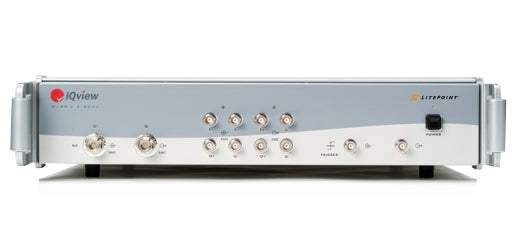

High-performance VSA
High-performance VSG
Simple control interfaces
The IQview™ 802.11a/b/g/n WLAN and Bluetooth Test Solution is an all-in-one test instrument developed specifically for RF testing of 802.11a/b/g/n WLAN and Bluetooth products. Suitable for both development and manufacturing environments, the IQview test system integrates a vector signal analyzer (VSA) and a vector signal generator (VSG) into a single instrument.
The IQview test system is expressly designed to test WLAN products, including network interface cards, access points, and embedded components.
The IQview test system’s VSA capability replaces traditional spectrum analyzers and power meters, enabling the user to analyze a device under test’s transmitter output and perform true error vector magnitude (EVM) measurements. Designed to receive large input signals without distortion, the IQview test system employs a wide-bandwidth Capture-Once Measure-All approach so that the device under test’s transmit signal is sampled and stored in a single measurement for subsequent analysis of all desired parameters resulting in reduced test times.
Similarly, the IQview test system’s VSG capability replaces traditional golden units with a test signal source of much higher quality, allowing detailed analysis of the receiver performance of the device under test. The IQview test system is designed to output high-quality test signals over the full expected operating range of a WLAN receiver.
The IQview test system supports testing in both the 2.4 GHz and 5 GHz frequency bands utilized worldwide for 802.11a/b/g/n products. Inputs and outputs at both RF and baseband are provided, enabling detailed testing of all aspects of a WLAN product’s analog design.
A vector signal analyzer (VSA) provides matching capabilities covering identical frequency bands as the VSG. Each VSA consists of two digitizer (DIG) channels (I and Q) and associated quadrature downconverter. The VSG consists of two arbitrary waveform generator (AWG) sections and a quadrature upconverter.
Control Interfaces
The IQview test system is bundled with the IQsignal™ Signal Analysis Software Suite, a powerful 802.11a/b/g/n analysis toolbox. Operating on a Windows PC and connected to the IQview test system via TCP/IP over Ethernet, IQsignal provides an intuitive graphical user interface that is easy to master. Users can interactively control and analyze IQview’s measurements and operation, either in real time or at their convenience. Because the tester control connection is Ethernet, the user can connect to the instrument from anywhere on their network, allowing seamless remote operation.
To allow automated testing, the IQview test system supports the LitePoint API, a complete command set and associated DLL files for the development of Visual C/C++ test scripts. Whether used for product characterization in the development process or for quality assurance in manufacturing, the LitePoint API supports test setup, data capture, signal analysis, and result-handling as well as general communications and error-handling functions.
To facilitate debugging, especially in the development of test scripts with the LitePoint API, the IQview test system is supported by the IQdebug™ Monitor and Control Tool. IQdebug is a convenient stand-alone software tool with an easy-touch graphical interface that can monitor and control the test instrument and data captures.
VSA Operation
The IQsignal software offers advanced analysis options that expand standard 802.11a/b/g/n analysis beyond basic power measurements, EVM measurements, or spectral measurements. For example, the IQsignal software can easily analyze frequency settling and phase noise that occurs during a burst transmission. Such capabilities significantly help in understanding and debugging RF performance-related issues. The IQview test system supports analysis of all the in-band transmit specifications required for compliance with the IEEE 802.11a/b/g/n standards. The IQsignal software provides graphical display of these tests, including spectral mask, symbol constellation (including EVM measurements), carrier leakage, spectral flatness (for 802.11a/g/n OFDM signals), power on/off ramp time (for 802.11b/g DSSS signals) and frequency error transmit power vs. time.
To support product debugging, various other graphical displays are supported by the IQsignal software, including:
Besides the graphical display of VSA measurements, the IQsignal software also presents relevant numerical data, including:
The IQsignal software additionally provides a wide range of compensation methods that can be used for advanced analysis of a captured signal’s sensitivity to certain impairments. For example, the available compensation methods when analyzing OFDM signals include:
Similarly, when analyzing DSSS signals, available compensation methods include equalization and DC offset removal.
VSG Operation
The IQsignal software also controls IQview’s VSG capabilities. The user can select, among various pre-defined test signals, adjusting the transmit frequency, the output power, and whether the transmitter should operate continuously or only transmit a specific number of packets.
Additionally, transmit impairments to the signal generated by the VSG, which could include the following, can be introduced in real time:
Supported WLAN Tests
The IQflex supports key WLAN tests including:
Supported Bluetooth (1.0, 2.0, 2.1) Hardware Tests
Analyzer
Generator
Supported Bluetooth (1.0, 2.0, 2.1) Measurement Tests
Model No
IQVIEW
Condition
Used
Manufacturer
LitePoint
Hey👋Let's start with your email